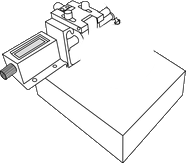LIQUID LIMIT TEST
Objective:
To determine the consistency limit of soil sample by liquid limit test.
Apparatus used:
Weighing machine, Grooving tool, Porcelain evaporating dish, Casagrande device, Container etc.





 Description
A fine-grained soil can exist in four states, namely, liquid, plastic, semi-solid, or solid-state, depending upon the content of water in it. The water content at which the soil changes from one state to another state is named consistency limits or Atterberg limits.
Description
A fine-grained soil can exist in four states, namely, liquid, plastic, semi-solid, or solid-state, depending upon the content of water in it. The water content at which the soil changes from one state to another state is named consistency limits or Atterberg limits.
Take air dried soil in a Porcelain evaporating dish and measure it up to 120g using weighing machine.






Place 425µm sieve on the pan and pour weighed quantity of air dried soil to the sieve then close the lid.






Place the set of sieves in the mechanical shaker and allow to shake for 10 minutes.












Collect the residue left on the 425µm sieve in a separate container.



















Mix the soil sample in the evaporating dish thoroughly with distilled water to form a uniform paste.








Place a portion of the paste in the cup of Casagrande device and spread it with a few strokes of spatula.










Using the grooving tool, cut a groove along the centre line of soil paste in the cup, so that clean sharp groove of proper dimension is formed.



Lift and drop the cup by turning crank at the rate of 2 revolutions per second until the 2 halves of soil paste come in contact with each other by flow only. Then note down the number of blows, N.







Lift and drop the cup by turning crank until the 2 halves of soil paste come in contact with each other
Stop rotating the crank and note down number of blows
0000
Measure the weight of empty container.



Weight of empty container, (W1) = _________ g
Take a representative portion of soil in a container from the cup and then measure its weight for moisture content determination.








Weight of container + wet soil, (W2) = _________ g
Place the container with wet soil sample in the oven for 24 hours at 115°C temperature.



After 24 hours
Measure the weight of the dry soil sample.





0.003
Weight of container + dry soil, (W3) = _________ g
Observations:
| Trial No. | |
| Number of drops, N | |
| Weight of container, W1 | |
| Weight of container + wet soil, (W2) | |
| Weight of container + oven dry soil, W3 |
Variables used in calculation:
| Weight of water, W4 (g) | W2 - W3 |
| Weight of dry soil, W5 (g) | W3 - W1 |
Calculations:
| Water content, W = | Weight of water⁄Weight of dry soil x 100 |
| = | % |
Repeat the procedure from step 6 - 13
Observations:
| Trial No. | No. of drops, N | Weight of container, W1 (g) | Weight of container + wet soil, W2 (g) | Weight of container + oven dry soil, W3 (g) | Weight of water, W4 (g) W4 = W2 - W3 | Weight of dry soil, W5 (g) W5 = W3 - W1 | Water content, W (%) W = W4⁄W5 x 100 |
Calculations:
| Average water content = | % |
Plastic limit of given soil sample
Characteristic Curve
Calculations
| Flow index, IF = | W1 - W2⁄ log(N2⁄N1) |
| = | |
| Plasticity index, IP = | WL - WP |
| = | % |
| Toughness index = | IP⁄IF |
| = | % |

